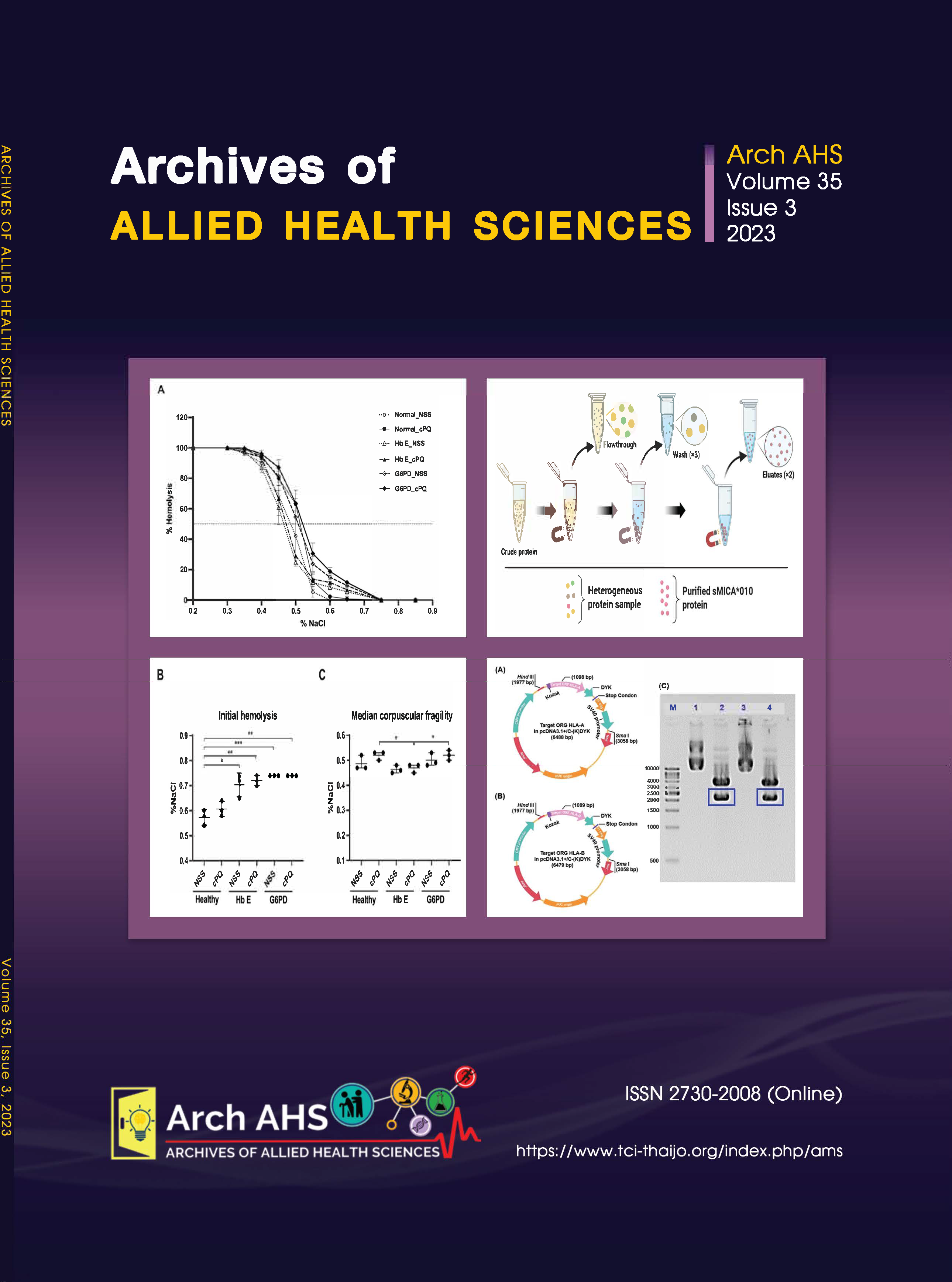Gross motor and language developmental stimulation via play during sitting attainment in orphaned infants
Main Article Content
Abstract
Orphaned infants often show delayed language development due to their limited child-rearing practices. The stimulation of language development before the attainment of sitting is questionable. The aim was to compare the scores of language and gross motor development before and after one-month stimulation program. Two groups of 20 healthy full-term orphaned infants aged 6-9 months were recruited for this quasiexperimental study. The first group consisted of infants who sat with support, and the second group consisted of those who sat independently. All infants received routine care and a program of substitutional 45-minute structured play three days per week for four weeks. The gross motor development of infants was directly observed using the Alberta Infant Motor Scale, and language development was assessed using the Communication and Symbolic Behaviors Scales-Developmental Profile Infant-Toddler Checklist at the pre- and post-four-week stimulation program. The differences in outcomes before and after intervention were examined using the paired t-test and the Wilcoxon signed-rank test. There were no significant differences in the means of language scores before and after four-week stimulation programs in both groups of infants, while both groups exhibited significant differences in gross motor development. Therefore, the stimulation program via play while attaining sitting skills may enhance language development in orphaned infants.
Article Details

This work is licensed under a Creative Commons Attribution-NonCommercial-NoDerivatives 4.0 International License.
References
Prommin S, Bennett S, Mato L, Siritaratiwat W. Longitudinal assessments of gross motor development in orphaned infants. J Med Tech Phy Ther 2017; 29(3): 337-49.
Prommin S, Bennett S, Keeratisiroj O, Siritaratiwat W. Instability of gross motor development during the first year in orphaned infants: A longitudinal observational study. Early Child Dev Care 2020; 190(13): 2041-9.
Worku BN, Abessa TG, Franssen E, Vanvuchelen M, Kolsteren P, Granitzer M. Development, social-emotional behavior and resilience of orphaned children in a family-oriented setting. J Child Fam Stud 2018; 27(2): 465-74.
Chaibal S, Bennett S, Rattanathanthong K, Siritaratiwat W. Early developmental milestones and age of independent walking in orphans compared with typical home-raised infants. Early Hum Dev 2016; 101: 23-6.
Hearst MO, Himes JH, Johnson DE, Kroupina M, Syzdykova A, Kroupina M, et al. Growth, nutritional, and developmental status of young children living in orphanages in Kazakhstan. Infant Ment Health J 2014; 35(2): 94-101.
Rachwani J, Santamaria V, Sandra L, Saavedra SL, Wood S, Porter F, et al. Segmental trunk control acquisition and reaching in typically developing infants. Exp Brain Res 2013; 228(1): 131-9.
Libertus K, Violi DA. Sit to talk: Relation between motor skills and language development in infancy. Front Psychol 2016; 7: 475.
WHO Multicentre Growth Reference Study Group. WHO motor development study: Windows of achievement for six gross motor development milestones. Acta Paediatr 2006; 95: 86-95.
Van Balen LC, Dijkstra LJ, Hadders-Algra M. Development of postural adjustments during reaching in typically developing infants from 4 to 18 months. Exp Brain Res 2012; 220(2): 109-19.
Adolph KE, Karasik LB, Tamis-LeMonda CS. Moving between cultures: Cross-cultural research on motor development. In Bornstein M, editor. Handbook of cross-cul tural developmental science, New York; 2010. p.1-23.
Oudgenoeg-Paz O, Volman MCJ, Leseman PP. Attainment of sitting and walking predicts development of productive vocabulary between ages 16 and 28 months. Infant Behav Dev 2012; 35(4): 733-6.
Alcock KJ, Krawczyk K. Individual differences in language development: Relationship with motor skill at 21 months. Dev Sci 2010; 13(5): 677-91.
Houwen S, Visser L, van der Putten A, Vlaskamp C. The interrelationships between motor, cognitive, and language development in children with and without intellectual and developmental disabilities. Res Dev Disabil 2016; 53: 19-31.
He M, Walle EA, Campos JJ. A cross-national investigation of the relationship between infant walking and language development. Infant 2015; 20: 283-305.
Schwartz ER. Speech and language disorders. In: Schwartz MW, editor. Pediatric Primary Care: A Problem-Oriented Approach. St. Louis: Mosby; 1990. p. 696-700.
Muluk NB, Bayoglu B, Anlar B. A study of language development and affecting factors in children aged 5 to 27 months. Ear Nose Throat J 2016; 95: 23-9.
Darrah J, Redfern L, Maguire TO, Beaulne AP, Watt J. Intra-individual stability of rate of gross motor development in full-term infants. Early Hum Dev 1998; 52(2): 169-79.
Piper MC, Pinnell LE, Darrah J, Maguire T, Byrne PJ. Construction and validation of the Alberta Infants Motor Scale (AIMS). Can J Public Health 1992; 83: S46-50.
Taneja V, Aggarwal R, Beri RS, Puliyel JM. Not by bread alone project: A 2-year follow-up report. Child Care Health Dev 2005; 31: 703-6.
Wetherby AW, Allen L, Cleary J, Kublin K, Goldstein H. Validity and reliability of the Communication and Symbolic Behavior Scales Developmental Profile with very young children. J Speech Lang Hear Res 2002; 45: 1202-18.
Aimsamrarn P, Janyachareon T, Rattanathanthong K, Emasithi A, Siritaratiwat W. Cultural translation and adaptation of the Alberta Infant Motor Scale Thai version. Early Hum Dev 2019; 130: 65-70.
Fowler J, Jarvis P, Chevannes M. Practical statistics for nursing and health care. UK: John Wiley and Sons; 2021.
Darrah J, Senthilselvan A, Magill-Evans, J. Trajectories of serial motor scores of typically developing children: Implications for clinical decision making. Infant Behav Dev 2009; 32(1): 72-8.
Wijnhoven TM, de Onis M, Onyango AW, Wang T, Bjoerneboe GE, Bhandari N. WHO Multicentre Growth Reference Study Group. Assessment of gross motor development in the WHO Multicentre Growth Reference Study. Food Nutr Bull 2004; 25: 37-45.
Onis M. WHO motor development study: Windows of achievement for six gross motor development milestones. Acta Paediatr 2006; 95: 86-95.
Harbourne RT, Ryalls B, Stergiou N. Sitting and looking: A comparison of stability and visual exploration in infants with typical development and infants with motor delay. Phys Occup Ther Pediatr 2014; 34(2): 197-212.
Greco ALR, da Costa CSN, Tudella E. Identifying the level of trunk control of healthy term infants aged from 6 to 9 months. Infants Behav Dev 2018; 50: 207-21.


